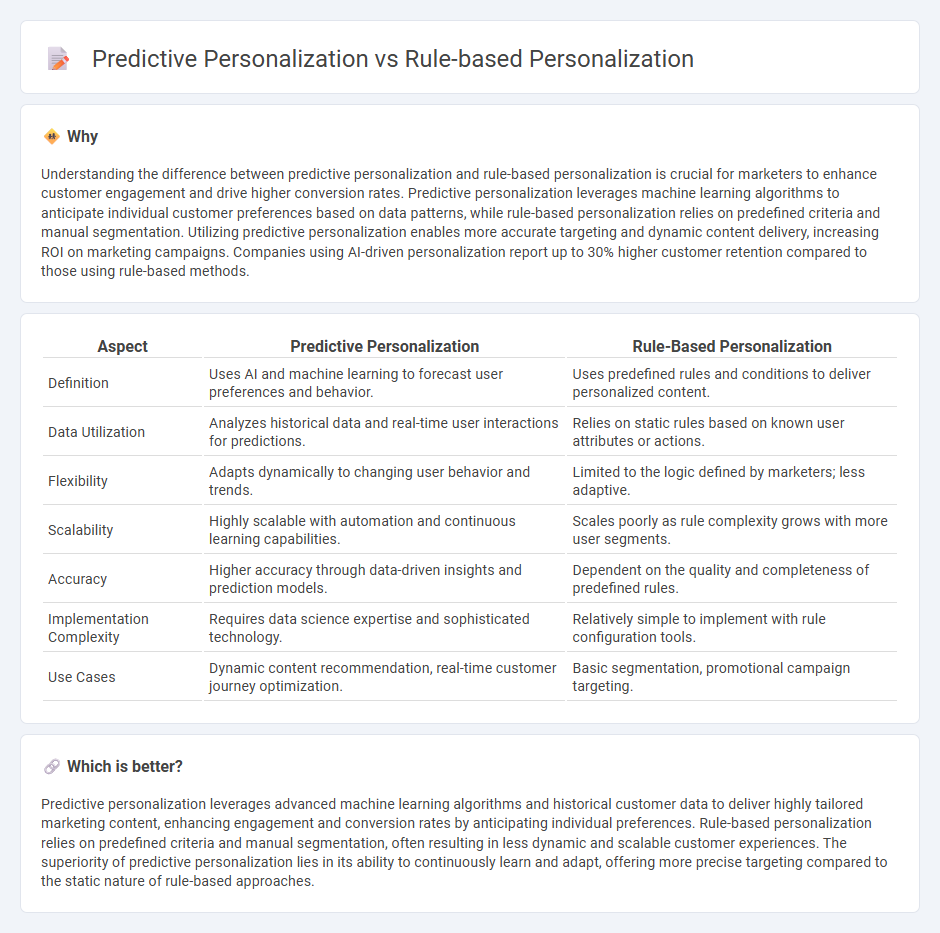
Predictive personalization leverages machine learning algorithms and customer data to anticipate user preferences and behaviors, creating dynamic, individualized experiences that evolve in real-time. Rule-based personalization relies on predefined criteria and segmentation rules to deliver targeted content, often resulting in static and less flexible user interactions. Explore how these methods transform marketing strategies and drive customer engagement.
Why it is important
Understanding the difference between predictive personalization and rule-based personalization is crucial for marketers to enhance customer engagement and drive higher conversion rates. Predictive personalization leverages machine learning algorithms to anticipate individual customer preferences based on data patterns, while rule-based personalization relies on predefined criteria and manual segmentation. Utilizing predictive personalization enables more accurate targeting and dynamic content delivery, increasing ROI on marketing campaigns. Companies using AI-driven personalization report up to 30% higher customer retention compared to those using rule-based methods.
Comparison Table
| Aspect | Predictive Personalization | Rule-Based Personalization |
|---|---|---|
| Definition | Uses AI and machine learning to forecast user preferences and behavior. | Uses predefined rules and conditions to deliver personalized content. |
| Data Utilization | Analyzes historical data and real-time user interactions for predictions. | Relies on static rules based on known user attributes or actions. |
| Flexibility | Adapts dynamically to changing user behavior and trends. | Limited to the logic defined by marketers; less adaptive. |
| Scalability | Highly scalable with automation and continuous learning capabilities. | Scales poorly as rule complexity grows with more user segments. |
| Accuracy | Higher accuracy through data-driven insights and prediction models. | Dependent on the quality and completeness of predefined rules. |
| Implementation Complexity | Requires data science expertise and sophisticated technology. | Relatively simple to implement with rule configuration tools. |
| Use Cases | Dynamic content recommendation, real-time customer journey optimization. | Basic segmentation, promotional campaign targeting. |
Which is better?
Predictive personalization leverages advanced machine learning algorithms and historical customer data to deliver highly tailored marketing content, enhancing engagement and conversion rates by anticipating individual preferences. Rule-based personalization relies on predefined criteria and manual segmentation, often resulting in less dynamic and scalable customer experiences. The superiority of predictive personalization lies in its ability to continuously learn and adapt, offering more precise targeting compared to the static nature of rule-based approaches.
Connection
Predictive personalization and rule-based personalization are connected through their shared goal of enhancing customer experiences by delivering tailored content. Rule-based personalization relies on predefined criteria such as demographics or past behavior, while predictive personalization uses machine learning algorithms to forecast future actions and preferences. Combining these approaches enables marketers to create more accurate, dynamic, and engaging campaigns that drive higher conversion rates.
Key Terms
If-Then Rules
Rule-based personalization employs If-Then rules to deliver tailored content by defining specific conditions and corresponding actions, ensuring precise control over user experience. Predictive personalization utilizes machine learning algorithms to analyze user behavior patterns and forecast preferences, enabling dynamic and adaptive targeting without explicit rule definitions. Discover how these approaches can transform your personalization strategy by diving deeper into their mechanisms and applications.
Machine Learning
Rule-based personalization relies on predefined criteria and static rules to tailor user experiences, making it less flexible but easier to implement. Predictive personalization leverages machine learning algorithms to analyze user behavior patterns and predict preferences in real-time, resulting in highly dynamic and precise content delivery. Explore the advantages of machine learning-driven personalization to enhance user engagement and conversion rates.
User Segmentation
Rule-based personalization uses predefined user segments based on explicit criteria such as demographics, location, or past behaviors to deliver tailored content. Predictive personalization leverages machine learning algorithms to analyze user data and predict future behaviors, enabling dynamic and precise segmentation for real-time customization. Explore how advanced user segmentation techniques can elevate your personalization strategy.
Source and External Links
What is rule-based personalization, and why you should care - Rule-based personalization lets brands create "if/then" logic rules that automatically display personalized content based on customer behavior, demographics, and purchase history, enabling hyper-relevant experiences once defined conditions are met.
Examining Rules-Based and Intent-Based Personalization - Rules-based personalization operates on manually programmed if/then logic to personalize user experiences and requires close collaboration between marketers and developers, acting on defined triggers like "clicked add to cart" or URL keywords to determine content shown.
Rules-based personalization: creating a personalization strategy - This approach delivers personalized experiences by defining multiple conditional rules, commonly using if/then/and/or logic based on explicit first-party data, allowing marketers to show tailored content for specific audience segments.
 dowidth.com
dowidth.com